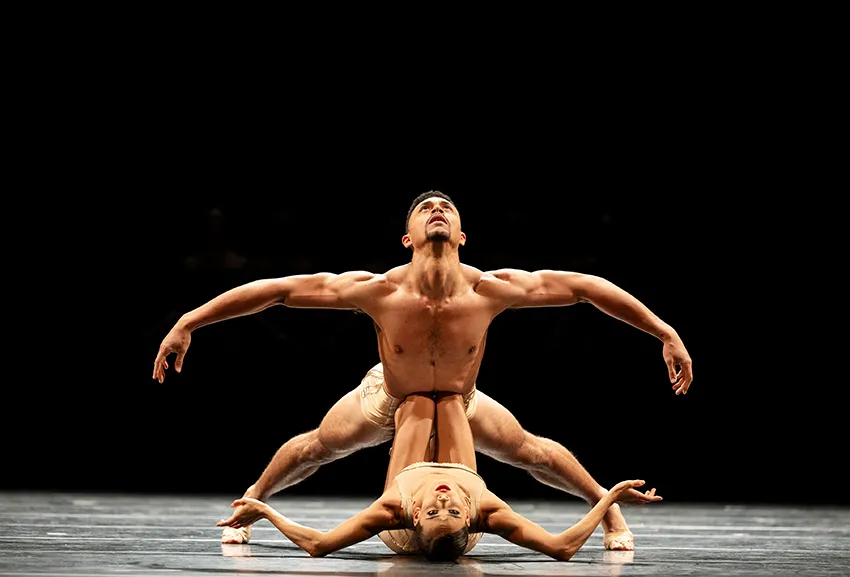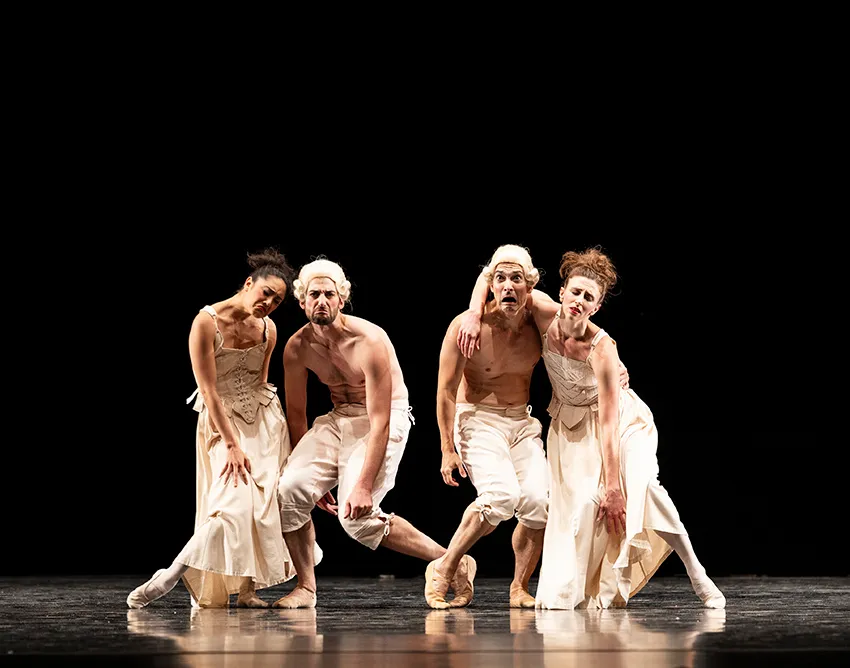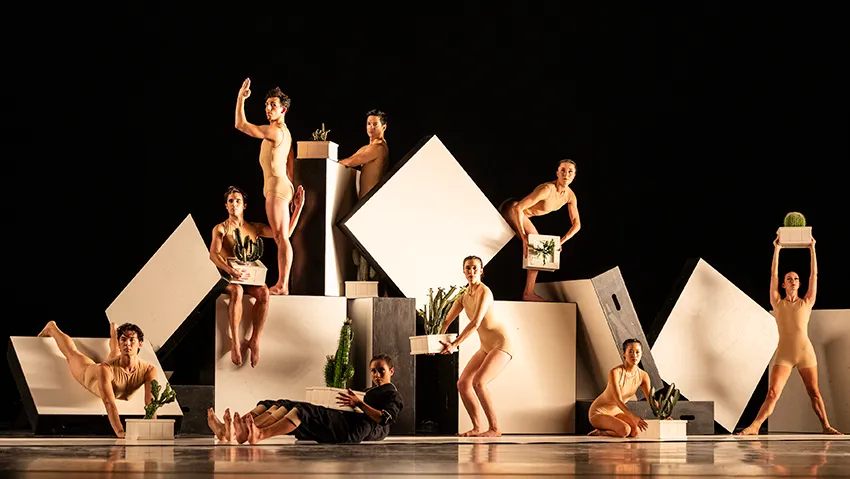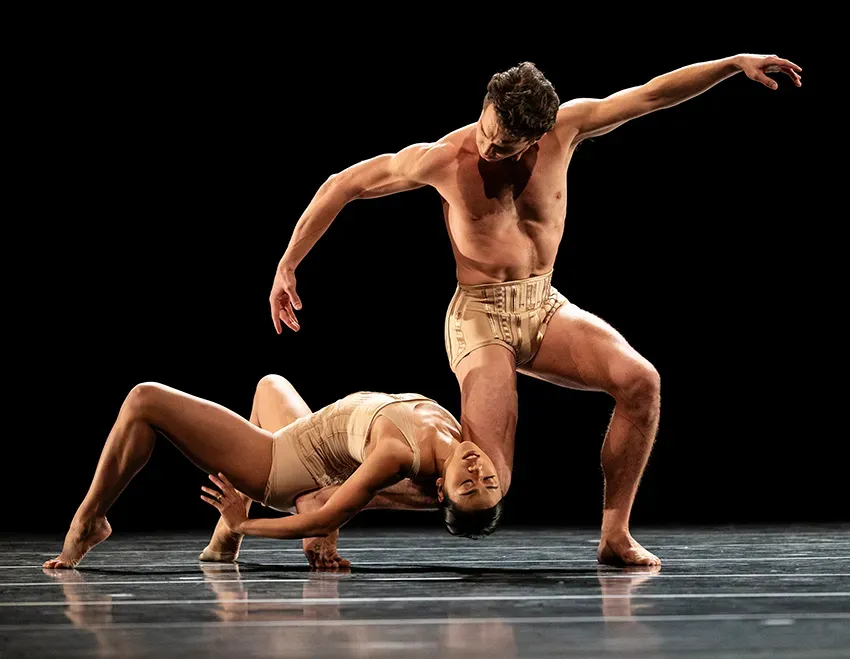PACIFIC NORTHWEST BALLET
CHOREOGRAPHY BY JIRÍ KYLIÁN AND ALEXANDER EKMAN
MCCAW HALL
SEPTEMBER 22, 2023
The season opener at Pacific Northwest Ballet on Friday was a festival of erotic and heart-pumping rhythms in three dances particularly suited to the youthful vigor and beauty of the PNB performers. The first two pieces were set to music by that sexy rascal, Wolfgang Amadeus Mozart, with Haydn, Beethoven, and Schubert making their appearances after the intermission – all played beautifully by the PNB orchestra led by Emil de Cou.
"Petite mort" is the French term for orgasm – or the droopy delight of postcoital collapse – and we see both conditions (mostly the orgasmic parts) in these three fabulous performances.
The first half of the evening – two dances by the great Czech choreographer Jirí Kylián – struck a delicate balance: first, the intense opener, Petite Mort, then the hilarious send-up of 18th-century style in Sechs Tänze. The evening's finale, Cacti, by Alexander Ekman of Sweden, premiered at PNB in 2018 to the same uproarious applause it enjoyed now. All three parts had the McCaw Hall audience punctuating their standing ovations with whoops and hollers.
And here's the good news: this wonderful program is at McCaw Hall through October 1. If there was ever a great date evening, this is it! Or just go to see some of the best dance and most beautiful music you'll enjoy this season.

Petite Mort (1991)
Jirí Kylián, choreography
Wolfgang Amadeus Mozart, composer: Piano concerto in A Major adagio and Piano concerto in C Major andante
Christina Siemens, pianist
Six couples are dressed in skin-toned costumes – at once erotically minimal and elegantly confined, with boning on the men's briefs and the women's bustiers. They appear to be both naked and classical, like Michelangelo's David. Yet their moves are unmistakable – more positions than most people could imagine – and unmistakably loving because of Mozart's accompanying music. The familiar piano movements, played with elegant tenderness by Christina Siemens, make what could be seen as elaborate and systematic sex into acts of thoughtful passion.
The dance begins with six seminude men alone onstage, facing the audience like soldiers, each with a rapier (whiplike swords) that they manipulated with amazing precision. The opening portion was silent so that the audience could hear the swish! of each sword as it cut the air, or as the men rolled the rapiers in circles on the ground.
In addition to the obvious showmanship of symbolic penises, the audience witnessed truly remarkable and difficult choreography. In the subsequent sequences, each pair performed their own coupling in time with music – sometimes astonishingly energetic, sometimes woozy and dreamy – but always a beautiful embodiment of love and Mozart.

Sechs Tänze (Six Dances)
Jirí Kylián, choreography
Wolfgang Amadeus Mozart, composer
Here we see Mozart in his embodied silliness, with the performers wearing 18th-century-style white wigs and underwear. In each short piece, Kylián gives the couples flirtatious dances that bounce along on the beat, like puppets discovering erotica for the first time.
The wit and humor of the choreography was matched by the audience's laughter. I found myself grinning and tapping my feet the whole time. What could be more jolly? After the solemn, beautiful erotica of Petite Mort, these bouncy dances supplied the playful reminder that sex is fun.

Cacti (2010)
Alexander Ekman, choreography
Franz Josef Haydn, Ludwig van Beethoven, Franz Schubert, composers
Sixteen performers are frozen on small platforms while a snooty academic voice talks about art in a language that suggests that knowledge is condescending rather than elevating or powerful. The dancers appeared to be trapped by some mean professor. I had trouble entering into this aspect of the piece in 2018 (full disclosure: I'm a professor), and I had the same reaction this time. Why make education sound distancing and cruel?
Fortunately that voice went away in time to let the dancers show us all the ways you can move on a tiny platform, and how simultaneous movement among sixteen powerful performers, all dressed in identical black and white, can thrill and mesmerize the viewer with rhythmic movement.
By the end, the snooty voice was forgotten, and the audience was cheering in the sheer joy of witnessing such a thrilling and often hilarious piece. The PNB dancers are masters of simultaneous and exhausting movement that builds and builds until the whole auditorium is breathless. It's a great performance, full of surprises.
My hope is that by now the youthful Alexander Ekman has moved away from framing his choreography with unnecessary voiceovers. Great dance makers don't need gimmicks, and he's truly one of those.
Get yourself and your friends to McCaw Hall by October 1 if you want to have a wonderful evening of laughter, love, brilliant music, and terrific dance.


